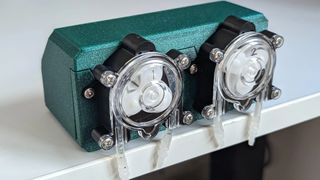Raspberry Pi Pico Powered Dosing System Keeps Fish Happy
Finding Pico

Whether you have expensive tropical fish, delicate reefs, or humble goldfish, you need to keep your tank clean for your aquatic pets, and this Raspberry Pi Pico-powered dosing pump is just the thing. Created by yojoebosolo (Joe Stiff), this $18 (£14) tiny pump project provides microdoses of a chemical that maintains a fish tank.
The pump system is a peristaltic pump that uses mechanical manipulation to move the liquid through a tube. This pump system is commonly used in medical and scientific applications where precision and hygiene are key. The tube can be easily replaced as no liquids go through the pump (they are massaged through the tube), and they can be swapped for a different liquid. Yojoebosolo uses it to micro-dose various chemicals into a fish tank.
Powering the project is a Raspberry Pi Pico. Based on the low price in the Bill of Materials, we see that it was the Pico, not the Raspberry Pi Pico W. Details are dotted across the rather lengthy comments section. There we can see that a two-channel relay controls the pumps. We can only see one input, a micro USB port, on the back of the 3D-printed case. The relay is directly connected to the Pico's 5V supply, and a GPIO pin on the Pico controls the open/closed state of the relay contacts.



The 3D-printed case is simple but beautifully made. It must've been printed on one of the best 3D printers as it looks clean, with only a hint of stepping showing on the Glitz PLA emerald green filament. The front of the case holds the pumps, secured using machine screws. Looking inside the case, thanks to a downloadable 3D model that we sliced for our Elegoo Neptune 3 Pro, we can see where the Raspberry Pi Pico can be secured (left) and where the two channel relays are housed (right).
Other than keeping our aquatic friends happy, are there any other applications for this project? Of course! Plant watering is the most obvious application. A soil moisture sensor would report the conductivity of the soil — the drier it gets, the less it conducts. The Pico would then control the peristaltic pump to water the plant. If gardening isn't your thing, how about a drink? The same tech can be used to build a robot bartender. Using a few pumps, linked to various beverages, users can be offered a menu. After selecting a drink, the Pico would trigger the appropriate pumps to mix your favorite tipple.
All of the components, and a downloadable 3D model of the case, are in the thread. Yojoebosolo has put plenty of thought and effort into this build, so much so that it looks rather simplistic at a casual glance. However, it seems that the simplicity is the product of clear thinking.
MORE: Best RP2040 Boards
Stay on the Cutting Edge
Join the experts who read Tom's Hardware for the inside track on enthusiast PC tech news — and have for over 25 years. We'll send breaking news and in-depth reviews of CPUs, GPUs, AI, maker hardware and more straight to your inbox.
Les Pounder is an associate editor at Tom's Hardware. He is a creative technologist and for seven years has created projects to educate and inspire minds both young and old. He has worked with the Raspberry Pi Foundation to write and deliver their teacher training program "Picademy".
-
btmedic04 I'm going to have to try this out for my reef tank. Over the years, I've spent hundreds of dollars on dosing pumps, and if this works well, it could save me a ton of moneyReply -
SonoraTechnical I use Atlas-Scientific i2c enabled dosing pumps and Node-RED on RaspberryPi4 to run 3 channels of dosing on my planted aquariums. the Atlas-Sci stuff is a bit expensive and you could buy entire dosing solutions on Ebay cheaper.... However, I like supporting these guys as they are always developing fun new products. WhiteBox Labs is another provider of interesting solutions for RaspberryPi that I support as well.Reply
Most Popular



